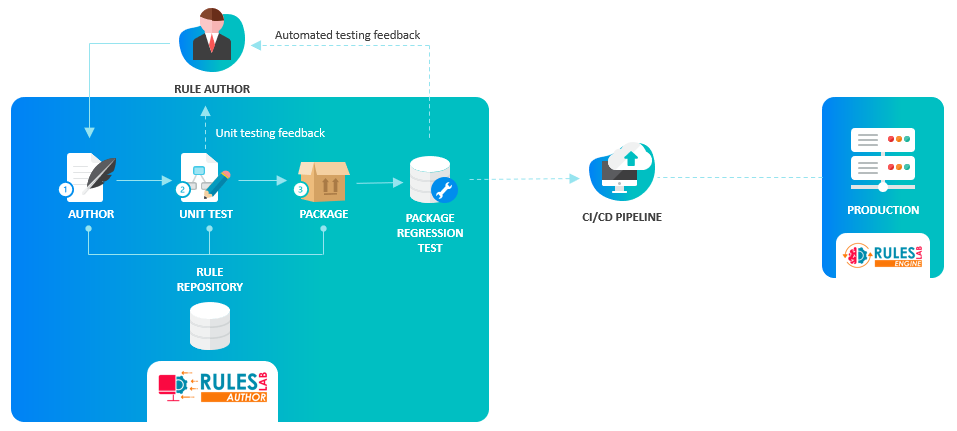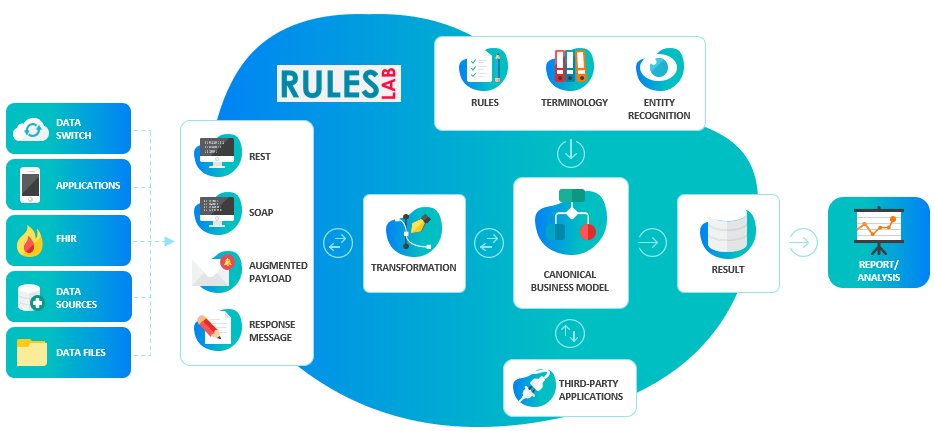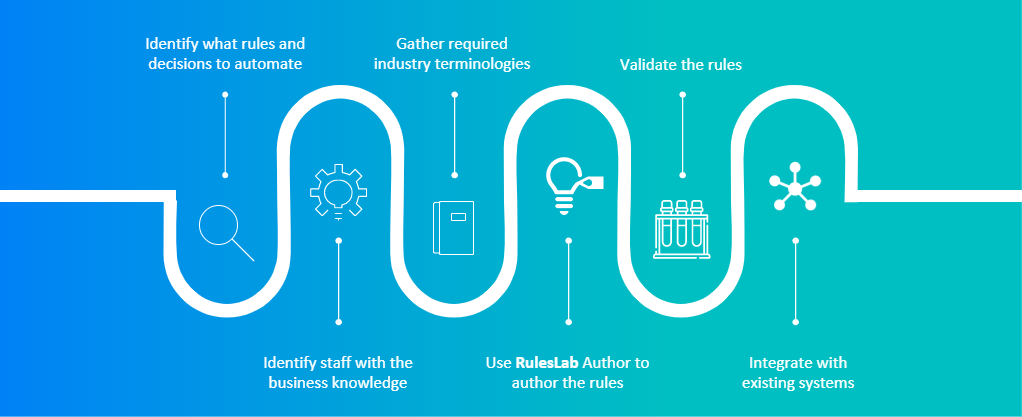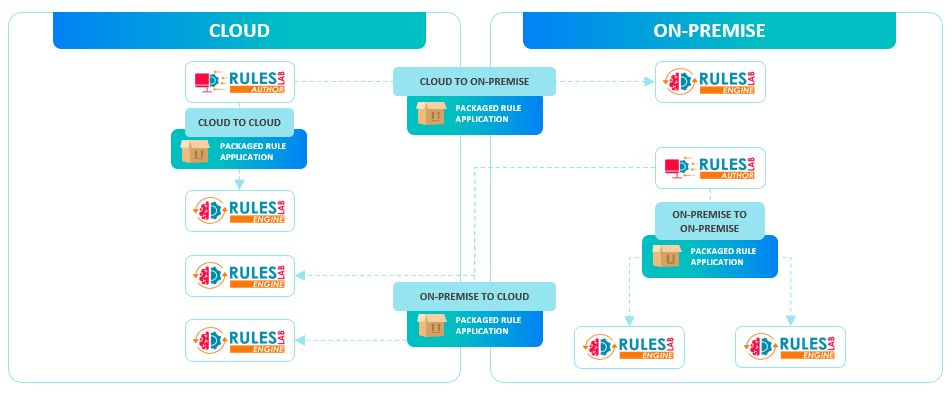Frequently
Asked
Questions

What is a domain and how is a domain used in RulesLab?
Within RulesLab, users can build their own “applications”, each containing packages of rules grouped together for a particular purpose (e.g. budget information, claim information, fraud investigation information).
For each application, the relevant business message structure (e.g. XML/JSON message format) is mapped to a rule application domain.
This mapping allows the RulesLab Author to understand the incoming data, providing a structure so that a rule can correctly reference a section in the message (e.g. patient name) and determine an outcome.
Organisations can create tailored domains, or choose to map their individual message structures to the universal FHIR standard.
Rules structured on the FHIR domain have several advantages:
-
- As they are not modelled directly on the business message structure, they are easily adaptable and transferable if other technologies within the organisation change.
- Utilising this universal structure allows rules to be shared easily amongst different users and organisations, a capability we will be supporting in the near future through our RulesLab Marketplace.
What is the structure of a rule application in RulesLab?

Who can build rules?
Any domain expert can build and manage rules in RulesLab. Our system is designed to be managed by subject matter experts, enabling them to replicate their decision-making process at scale.
How do I test my rules?
Rule authors are able to complete unit tests on the fly at both a rule and rule term level. This is done via a user-friendly interface, where authors can easily input the necessary test values, and receive a quick pass/fail result (rather than spending time crafting up intricate test XMLs and interpreting the returned outputs). Users can then get immediate feedback on any rule updates before they are promoted to the RulesLab Engine.
RulesLab allows these unit tests to be saved, and then re-run after any future changes to the rules and terms. These saved tests can also be compiled into application-level test suites, enabling users to easily regression test the entire rule application when changes are made to the granular rule terms, ensuring that none of the pre-existing rules have been compromised.

Can I share my rules with other organisations?
Absolutely. We offer the ability to export and import applications in the RulesLab Author, enabling the sharing of rules between different teams within an organisation, or even different companies, regardless of whether they are using different business systems.
If you’re importing an application from another source, no structural changes to the rules should be required to (unless you want to update any finer details, such as specific values or list references). All that is needed to integrate the application with your system is a new Extensible Stylesheet Language Transformation (XSLT) to map your specific incoming message structure to the application’s internal domain model.
In the near future, we will be supporting the sharing of rule applications through our RulesLab Marketplace.

Can RulesLab be used as a clinical decision support system?
The expert system/decision support knowledge base can easily be configured in the RulesLab Author, such as decisions required on the clinical validity of a medical insurance claim, or the next best treatment action advice based on EMR data inputs.
This decision support capability can then be integrated into current operational systems with relative ease, by embedding the RulesLab Engine in EMR, adjudication or any other straight-through processing operational systems.
How do I embed RulesLab into my existing applications?
RulesLab is specifically designed with integration and multiple business calling systems and message formats in mind.
RulesLab makes use of Apache Camel, an open-source integration framework that empowers you to quickly and easily integrate various systems consuming or producing data. Camel supports most of the Enterprise Integration Patterns, as well as the newer integration patterns from micro-service architectures, to help solve integration problems by applying best practice “out-of-the-box” integrations, including, but not limited to:
-
- File transfer
- Shared data
- Remote application calls
- Messaging

RulesLab can be custom tailored to fit into your organisation’s business applications and integration environments, and can support unique and complex requirements.
Out of the box, the RulesLab platform supports the following API integrations, as well as real-time and batch operations:
-
- REST, JSON
- SOAP, XML
- Batch, Excel, CSV
- Remote function calls (APIs)
How much effort is it to install and configure RulesLab initially?
The recommend approach before installation is that an analysis of all rules is undertaken, which will then inform the configuration and integration process. This will not only ensure that all current requirements are taken into account, but also that the configuration is executed in such a way to allow for future changes with limited to no impact.
There are several factors that need to be considered before before for integration and setup, which include, but are not limited to:
-
- Number of business domain areas
- Data structures and availability of business data
- Real-time SLA requirements
- Frequency of change to embed rules
- Source system capabilities
- Security and role requirements
Typically the following steps are involved in installing and integrating RulesLab an the organisation’s current system:

What are my options to deploy RulesLab?
The separation of the RulesLab Author from the execution Engine allows for an extremely flexible deployment model to suit an unrestricted combination of on-premises and cloud deployments. The rule applications are agnostic to cloud and on-premises deployments, and not only allow for these variations, but also for the following distribution models:
-
- Centralised Authoring – Distributed Execution
- Distributed Authoring – Distributed Execution
- Distributed Authoring – Centralised Execution
- Centralised Authoring – Distributed Execution

How do I scale RulesLab?
To ensure RulesLab can meet periods of peak demand, it is able to scale in a variety of ways. Many RulesLab Engines can run side-by-side, with any combination of RulesLab applications running on each of them. If one RulesLab application is processing significantly higher numbers of items than others, then one or more load-balanced RulesLab Engines might be dedicated to that process, and the others shared across a separate RulesLab Engine.
How is security handled in RulesLab?
RulesLab is built with data security at front and centre, leveraging industry standard encryption, secure connections, and reverse proxy technology. Additionally, sensitive data is not persisted within RulesLab. The RulesLab Engine and Author components are capable of analysing anonymised data and responding back to the calling system, without the requirement for identifiable information.

